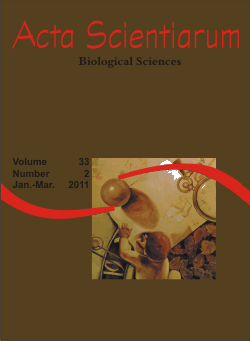<b>Food partitioning between sympatric species of <em>Serrapinnus</em> (Osteichthyes, Cheirodontinae) in a tropical stream</b> - doi: 10.4025/actascibiolsci.v33i2.7593
Keywords:
Serrapinnus, diet, coexistence, stream
Abstract
This study investigated the feeding habits of Serrapinnus microdon and S. calliurus and possible seasonal differences (rainy and dry seasons) in the utilization of food. The fish were collected monthly in Cancela stream, in the basin of the Manso/Cuiabá rivers in the State of Mato Grosso, from March 2003 to February 2004. Both species preferentially consumed resources of autochthonous origin, independently of the season. The diet of S. microdon was basically composed by immature forms of aquatic insects, with Chironomidae and Ephemeroptera predominating during the entire study period, thus showing a restricted diet (Ba = 0.27 in the rainy season, and 0.29 in the dry season). For S. calliurus, aquatic insects (especially Ephemeroptera) were equally important, but algae and detritus were also prominent depending on the season, showing a less specialized diet (Ba = 0.44 in the rainy season, and Ba = 0.48 in the dry season). Both fish species presented a benthivorous feeding habit; however, everything indicates that they live together without competition, because the food on which they depend is widely available. Serrapinnus calliurus was susceptible to seasonal changes in the availability of food resources.Downloads
Download data is not yet available.
Published
2011-05-17
How to Cite
Alves, G. H. Z., Tófoli, R. M., Novakowski, G. C., & Hahn, N. S. (2011). <b>Food partitioning between sympatric species of <em>Serrapinnus</em> (Osteichthyes, Cheirodontinae) in a tropical stream</b> - doi: 10.4025/actascibiolsci.v33i2.7593. Acta Scientiarum. Biological Sciences, 33(2), 153-159. https://doi.org/10.4025/actascibiolsci.v33i2.7593
Issue
Section
Ecology and Limnology
DECLARATION OF ORIGINALITY AND COPYRIGHTS
I Declare that current article is original and has not been submitted for publication, in part or in whole, to any other national or international journal.
The copyrights belong exclusively to the authors. Published content is licensed under Creative Commons Attribution 4.0 (CC BY 4.0) guidelines, which allows sharing (copy and distribution of the material in any medium or format) and adaptation (remix, transform, and build upon the material) for any purpose, even commercially, under the terms of attribution.
Read this link for further information on how to use CC BY 4.0 properly.
0.6
2019CiteScore
31st percentile
Powered by 

0.6
2019CiteScore
31st percentile
Powered by 











1.png)




3.png)













